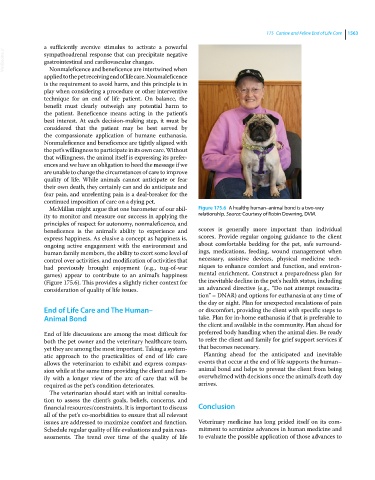Page 1625 - Clinical Small Animal Internal Medicine
P. 1625
175 Canine and Feline End of Life Care 1563
a sufficiently aversive stimulus to activate a powerful
VetBooks.ir sympathoadrenal response that can precipitate negative
gastrointestinal and cardiovascular changes.
Nonmaleficence and beneficence are intertwined when
applied to the pet receiving end of life care. Nonmaleficence
is the requirement to avoid harm, and this principle is in
play when considering a procedure or other interventive
technique for an end of life patient. On balance, the
benefit must clearly outweigh any potential harm to
the patient. Beneficence means acting in the patient’s
best interest. At each decision‐making step, it must be
considered that the patient may be best served by
the compassionate application of humane euthanasia.
Nonmaleficence and beneficence are tightly aligned with
the pet’s willingness to participate in its own care. Without
that willingness, the animal itself is expressing its prefer-
ences and we have an obligation to heed the message if we
are unable to change the circumstances of care to improve
quality of life. While animals cannot anticipate or fear
their own death, they certainly can and do anticipate and
fear pain, and unrelenting pain is a deal‐breaker for the
continued imposition of care on a dying pet.
McMillan might argue that one barometer of our abil- Figure 175.6 A healthy human–animal bond is a two‐way
ity to monitor and measure our success in applying the relationship. Source: Courtesy of Robin Downing, DVM.
principles of respect for autonomy, nonmaleficence, and
beneficence is the animal’s ability to experience and scores is generally more important than individual
express happiness. As elusive a concept as happiness is, scores. Provide regular ongoing guidance to the client
ongoing active engagement with the environment and about comfortable bedding for the pet, safe surround-
human family members, the ability to exert some level of ings, medications, feeding, wound management when
control over activities, and modification of activities that necessary, assistive devices, physical medicine tech-
had previously brought enjoyment (e.g., tug‐of‐war niques to enhance comfort and function, and environ-
games) appear to contribute to an animal’s happiness mental enrichment. Construct a preparedness plan for
(Figure 175.6). This provides a slightly richer context for the inevitable decline in the pet’s health status, including
consideration of quality of life issues. an advanced directive (e.g., “Do not attempt resuscita-
tion” – DNAR) and options for euthanasia at any time of
the day or night. Plan for unexpected escalations of pain
End of Life Care and The Human– or discomfort, providing the client with specific steps to
Animal Bond take. Plan for in‐home euthanasia if that is preferable to
the client and available in the community. Plan ahead for
End of life discussions are among the most difficult for preferred body handling when the animal dies. Be ready
both the pet owner and the veterinary healthcare team, to refer the client and family for grief support services if
yet they are among the most important. Taking a system- that becomes necessary.
atic approach to the practicalities of end of life care Planning ahead for the anticipated and inevitable
allows the veterinarian to exhibit and express compas- events that occur at the end of life supports the human–
sion while at the same time providing the client and fam- animal bond and helps to prevent the client from being
ily with a longer view of the arc of care that will be overwhelmed with decisions once the animal’s death day
required as the pet’s condition deteriorates. arrives.
The veterinarian should start with an initial consulta-
tion to assess the client’s goals, beliefs, concerns, and
financial resources/constraints. It is important to discuss Conclusion
all of the pet’s co‐morbidities to ensure that all relevant
issues are addressed to maximize comfort and function. Veterinary medicine has long prided itself on its com-
Schedule regular quality of life evaluations and pain reas- mitment to scrutinize advances in human medicine and
sessments. The trend over time of the quality of life to evaluate the possible application of those advances to

